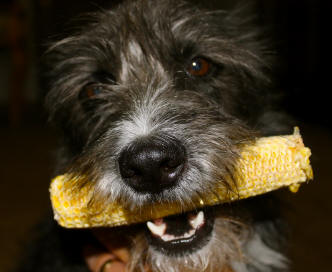Corn Cobs
Dr. Kimberly Brokaw, DVM
 (10/2015) Certain things such as bee stings and frostbite obviously have seasonal occurrences as far as when I see them at the clinic. One less obvious ailment that I see seasonally is dogs eating corn cobs. Most people are surprised to learn that unless the dog chews up the corn
cob really well before eating it, they can cause intestinal obstructions that require surgery to remove.
(10/2015) Certain things such as bee stings and frostbite obviously have seasonal occurrences as far as when I see them at the clinic. One less obvious ailment that I see seasonally is dogs eating corn cobs. Most people are surprised to learn that unless the dog chews up the corn
cob really well before eating it, they can cause intestinal obstructions that require surgery to remove.
This past week I saw and treated 3 dogs who ate corn cobs. While one required surgery, the other two had chewed the corn cobs up into small enough pieces that it didn't get stuck in their intestines. None of the dogs had corn cobs given to them by their owner but rather had stolen them from various places. One got it out of the trash at the dog park,
another jumped up and took it off the counter, and the third stole it out of the owner's kitchen trash can. Owners do the best they can to keep dogs away from poisonous substances, choking hazards, rotten food, and items like corn cobs that can obstruct the intestinal tract. Unfortunately, dogs can be clever when they want to do something that can cause harm to themselves.
Charm is a 4 year old black lab cross that her owner adopted from a rescue. She is sweet, playful, very high energy and into everything. These characteristics can be endearing to labrador owners, but can also try their patience. Charm's owner takes her to the dog park both before and after work to allow her to run around so that hopefully she will be
calm when in the house. She has taken Charm to multiple dog trainers, behaviorists, crystal therapists, and chakra re-aligners to try and help with Charm's exuberance. Charm's owner has found that taking Charm running at the dog park twice per day is the most effective technique for helping her behave like a good dog.
While at the dog park last week, the ever energetic Charm jumped into the trash can and ate a corn cob before her owner could take the corn cob away from her. Soon after, Charm started vomiting up bits of corn cob and she was taken the vet clinic by her concerned owner. Initially she was seen by one of the other vets at the practice. X-rays were taken
and no obstructions were seen. However, Charms' owner was cautioned by my colleague, that corn cobs are difficult to see on x-ray and she should be monitored closely.
The next day Charm's owner was back at the clinic to see me. While Charm wasn't vomiting, and was just as energetic as ever, her owner believed the corn cob was obstructing Charm's intestines. She hadn't seen her poop and the owner said Charm was painful. As I started to examine Charm, her worried owner brought out a piece of crystal on a metal chain.
As I was pushing on Charm's abdomen, the owner asked Charm if that was where it hurt, while spinning the crystal. As I pushed on Charm, the owner interpreted the movement of the crystal and told me if that was the painful area. Charm was very active and wasn't displaying any of the obvious signs of pain that I was used to interpreting but the owner
insisted that the crystal indicated that Charm was painful around her stomach and not the intestine.
Charm's owner even got into a conversation with Charm in which she asked if the dog was lying to her and explained to Charm that Charm had to tell the truth if she wanted the doctor to help her feel better. I suggested to the owner that we take x-rays to see if there was any corncob in the stomach even though I was more suspicious that it would be
further back since the vomiting had stopped and the dog was acting constipated instead. The owner happily agreed to the x-rays.
As it turns out Charm wasn't being completely honest with the crystal spinning thing. On x-ray, her stomach was empty. There were no signs of a corncob being stuck in her intestine, but her colon was full of fecal matter. I told the owner to give Charm a lot of fluids and take her for a long walk. I explained that I had a feeling that after she pooped,
Charm would be happy and back to her usual self. About half an hour later the owner called back. She happily told me that Charm had pooped. She thanked me for my help and for being so patient with her.
At this point in my career, I have learned not to question some of the more unique practices of my clients as long as it doesn't interfere with my ability to help their pet. In this case, crystal therapy was fine. The owner was attentive to her dog, was willing to to take the x-rays that I advised, and the dog received all the appropriate care.
Read other articles by Dr. Kim Brokaw